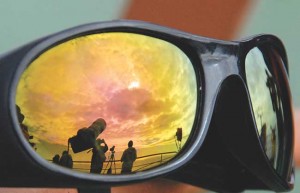 Recently published is BS EN ISO 12312-2: 2015 Eye and face protection – Sunglasses and related eyewear Part 2: Filters for direct observation of the sun. This gives the requirements for filters to use during an eclipse. The transmittance requirements are very similar to those in BS EN 1836: 2005 Personal eye-equipment – Sunglasses and sunglare filters for general use and filters for direct observation of the sun, except that a single overall range of luminous transmittance of between 0.0032 per cent and 0.000061 per cent is given rather than being divided into the five different shades or categories that is in EN 1836. For any particular luminous transmittance, the UV-A and infra-red radiation requirements are the same in both standards, though the UV-B requirement is now defined in terms of a weighted average over the wavelength range rather than a maximum spectral value.
Recently published is BS EN ISO 12312-2: 2015 Eye and face protection – Sunglasses and related eyewear Part 2: Filters for direct observation of the sun. This gives the requirements for filters to use during an eclipse. The transmittance requirements are very similar to those in BS EN 1836: 2005 Personal eye-equipment – Sunglasses and sunglare filters for general use and filters for direct observation of the sun, except that a single overall range of luminous transmittance of between 0.0032 per cent and 0.000061 per cent is given rather than being divided into the five different shades or categories that is in EN 1836. For any particular luminous transmittance, the UV-A and infra-red radiation requirements are the same in both standards, though the UV-B requirement is now defined in terms of a weighted average over the wavelength range rather than a maximum spectral value.
Register now to continue reading
Thank you for visiting Optician Online. Register now to access up to 10 news and opinion articles a month.
Register
Already have an account? Sign in here
